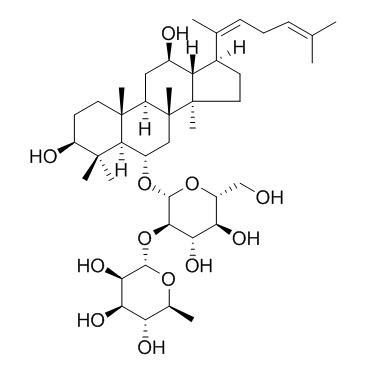Ginsenoside Rg4
Reference standards.
Inquire / Order:
manager@chemfaces.com
Technical Inquiries:
service@chemfaces.com
Tel:
+86-27-84237783
Fax:
+86-27-84254680
Address:
1 Building, No. 83, CheCheng Rd., Wuhan Economic and Technological Development Zone, Wuhan, Hubei 430056, PRC
Providing storage is as stated on the product vial and the vial is kept tightly sealed, the product can be stored for up to
24 months(2-8C).
Wherever possible, you should prepare and use solutions on the same day. However, if you need to make up stock solutions in advance, we recommend that you store the solution as aliquots in tightly sealed vials at -20C. Generally, these will be useable for up to two weeks. Before use, and prior to opening the vial we recommend that you allow your product to equilibrate to room temperature for at least 1 hour.
Need more advice on solubility, usage and handling? Please email to: service@chemfaces.com
The packaging of the product may have turned upside down during transportation, resulting in the natural compounds adhering to the neck or cap of the vial. take the vial out of its packaging and gently shake to let the compounds fall to the bottom of the vial. for liquid products, centrifuge at 200-500 RPM to gather the liquid at the bottom of the vial. try to avoid loss or contamination during handling.
Cancer Lett. 2023, 18:216584.
Evid-Based Compl Alt2020, 7202519:13
BMC Complement Med Ther. 2020, 20(1):94.
NanoBioScience2024, v13:3:115.
J Pharm Biomed Anal.2021, 196:113931.
J Sci Food Agric.2023, 103(1):213-220.
Res Pharm Sci.2023, 18(3):244-261.
FASEB J.2019, 33(2):2026-2036
The Journal of Korean Medicine2023, 44(4):26-40.
Foods.2024, 13(11):1739.
Related and Featured Products
Toxicol Environ Health A . 2019;82(5):338-350.
Inhibitory effects of protopanaxatriol type ginsenoside fraction (Rgx365) on particulate matter-induced pulmonary injury[Pubmed:
30917762]
Abstract
Inhalation of fine particulate matter (PM2.5) is associated with elevated pulmonary injury attributed to the loss of vascular barrier integrity. Black ginseng (BG), steamed 9 times and dried ginseng, and its major protopanaxatriol type ginsenosides (Ginsenoside Rg4, Rg6, Rh4, Rh1, and Rg2) exhibited various biological activities including anti-septic, anti-diabetic, wound healing, immune-stimulatory, and anti-antioxidant activity. The aim of this study was to investigate the beneficial effects of Rgx365 (a protopanaxatriol type rare ginsenosides fraction) on PM-induced lung endothelial cell (EC) barrier disruption and pulmonary inflammation. Permeability, leukocyte migration, activation of proinflammatory proteins, generation of reactive oxygen species (ROS), and histology were examined in PM2.5-treated EC and mice. Rgx365 significantly scavenged PM2.5-induced ROS, inhibited ROS-induced activation of p38 mitogen-activated protein kinase (MAPK), activated Akt in purified pulmonary EC, which helped maintain endothelial integrity. Further, Rgx365 reduced vascular protein leakage, leukocyte infiltration, and proinflammatory cytokine release in bronchoalveolar lavage fluids in PM-induced mouse lung tissues. Data suggested that Rgx365 might exhibit protective effects in PM-induced inflammatory lung injury and vascular hyperpermeability.
Keywords: Akt; Rgx365; particulate matter; vascular permeability.
Yao Xue Xue Bao. 1989;24(11):877-9.
A new minor saponin from the leaves of Panax ginseng C. A. Meyer.[Pubmed:
2618687]
METHODS AND RESULTS:
Two minor compounds isolated from the leaves of Panax ginseng C. A. Meyer were characterized as 20(R)-protopanaxadiol (I) and 3 beta, 6 alpha, 12 beta-trihydroxydammar-20 (22), 24-diene-6-O-alpha-L-rhamnosyl-(1----2)-beta-D-glucopyranoside (II) on the basis of spectral analysis and chemical evidences.
CONCLUSIONS:
I was isolated for the first time from the leaves; II was shown to be a new saponin and was named as Ginsenoside Rg4.



